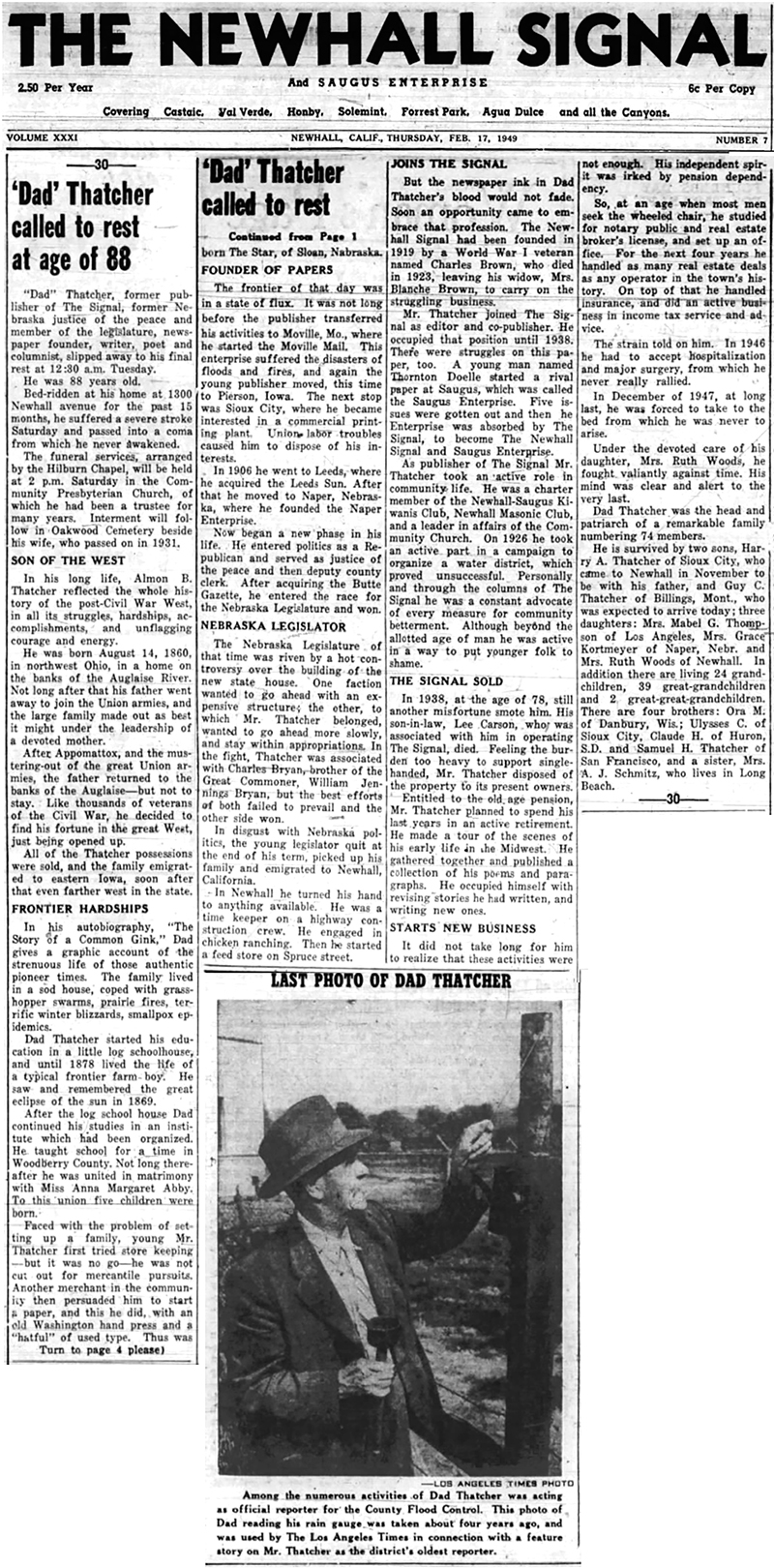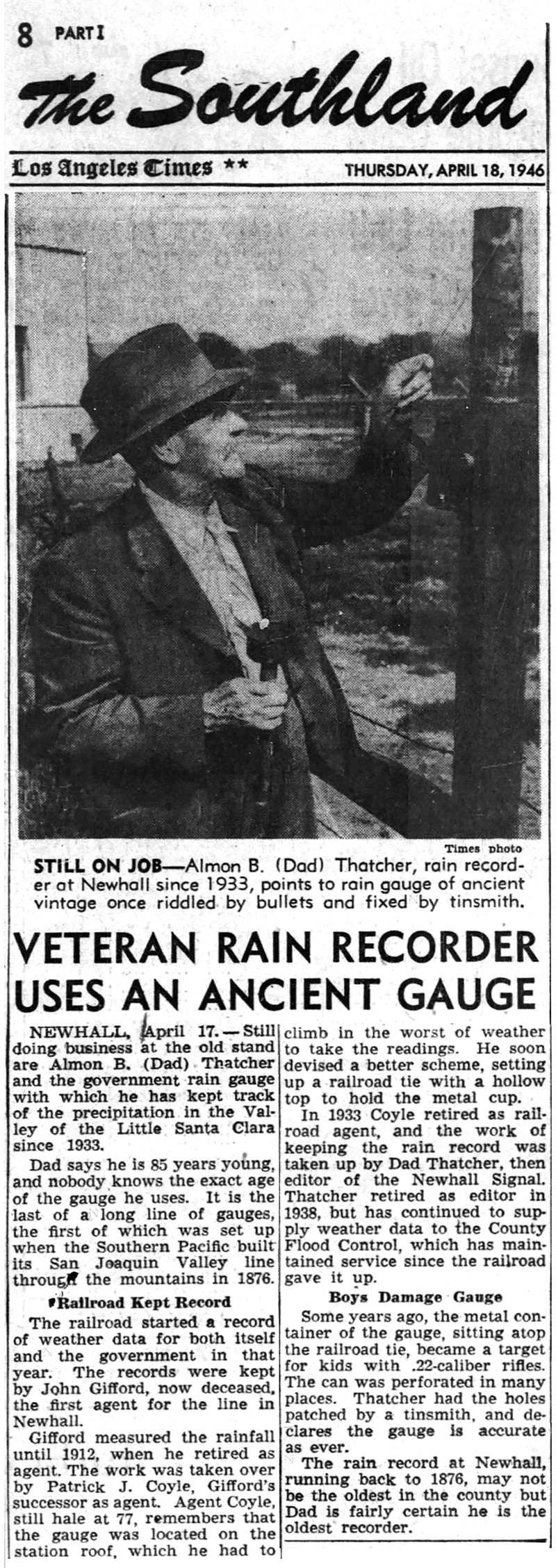'Dad' Thatcher Called to Rest at Age of 88.
The Newhall Signal and Saugus Enterprise | Thursday, February 17, 1949.
"Dad" Thatcher, former publisher of The Signal, former Nebraska justice of the peace and member of the legislature, newspaper founder, writer, poet and columnist, slipped away to his final rest at 12:30 a.m. Tuesday [February 15, 1949].
He was 88 years old.
Bed-ridden at his home at 1300 Newhall avenue for the past 15 months, he suffered a severe stroke Saturday and passed into a coma from which he never awakened.
The funeral services, arranged by the Hilburn Chapel, will be held at 2 p.m. Saturday in the Community Presbyterian Church, of which he had been a trustee for many years. Interment will follow in Oakwood Cemetery beside his wife, who passed on in 1931.
In his long life, Almon B. Thatcher reflected the whole history of the post-Civil War West, in all its struggles, hardships, accomplishments, and unflagging courage and energy.
He was born August 14, 1860, in northwest Ohio, in a home on the banks of the Auglaise River. Not long after that, his father went away to join the Union armies, and the large family made out as best it might under the leadership of a devoted mother.
After Appomattox, and the mustering-out of the great Union armies, the father returned to the banks of the Auglaise — but not to stay. Like thousands of veterans of the Civil War, he decided to find his fortune in the great West, just being opened up.
All of the Thatcher possessions were sold, and the family emigrated to eastern Iowa, soon after that even farther west in the state.
In his autobiography, "The Story of a Common Gink," Dad gives a graphic account of the strenuous life of those authentic pioneer times. The family lived in a sod house, coped with grasshopper swarms, prairie fires, terrific winter blizzards, smallpox epidemics.
Dad Thatcher started his education in a little log schoolhouse, and until 1878 lived the life of a typical frontier farm boy. He saw and remembered the great eclipse of the sun in 1869.
After the log school house, Dad continued his studies in an institute which had been organized. He taught school for a time in Woodberry County. Not long thereafter, he was united in matrimony with Miss Anna Margaret Abby. To this union five children were born.
Faced with the problem of setting up a family, young Mr. Thatcher first tried storekeeping — but it was no go — he was not cut out for mercantile pursuits. Another merchant in the community then persuaded him to start a paper, and this he did, with an old Washington hand press and a "hatful" of used type. Thus was born The Star, of Sloan, Nebraska.
The frontier of that day was in a state of flux. It was not long before the publisher transferred his activities to Moville, Mo., where he started the Moville Mail. This enterprise suffered the disasters of floods and fires, and again the young publisher moved, this time to Pierson, Iowa. The next stop was Sioux City, where he became interested in a commercial printing plant. Union labor troubles caused him to dispose of his interests.
In 1906 he went to Leeds, where he acquired the Leeds Sun. After that he moved to Naper, Nebraska, where he founded the Naper Enterprise.
Now began a new phase in his life. He entered politics as a Republican and served as justice of the peace and then deputy county clerk. After acquiring the Butte Gazette, he entered the race for the Nebraska Legislature and won.
The Nebraska Legislature of that time was riven by a hot controversy over the building of the new state house. One faction wanted to go ahead with an expensive structure; the other, to which Mr. Thatcher belonged, wanted to go ahead more slowly, and stay within appropriations. In the fight, Thatcher was associated with Charles Bryan, brother of the Great Commoner, William Jennings Bryan, but the best efforts at both failed to prevail and the other side won.
In disgust with Nebraska politics, the young legislator quit at the end of his term, picked up his family and emigrated to Newhall, California.
In Newhall he turned his hand to anything available. He was a timekeeper on a highway construction crew. He engaged in chicken ranching. Then he started a feed store on Spruce street.
But the newspaper ink in Dad Thatcher's blood would not fade. Soon an opportunity came to embrace that profession. The Newhall Signal had been founded in 1919 by a World War I veteran named Charles Brown, who died in 1923, leaving his widow, Mrs. Blanche Brown, to carry on the struggling business.
Mr. Thatcher joined The Signal as editor and co-publisher. He occupied that position until 1938. There were struggles on this paper, too. A young man named Thornton Doelle started a rival paper at Saugus, which was called the Saugus Enterprise. Five issues were gotten out, and then the Enterprise was absorbed by The Signal, to become The Newhall Signal and Saugus Enterprise.
As publisher of The Signal, Mr. Thatcher took an active role in community life. He was a charter member of the Newhall-Saugus Kiwanis Club, Newhall Masonic Club, and a leader in affairs of the Community Church. In 1926 he took an active part in a campaign to organize a water district, which proved unsuccessful. Personally and through the columns of The Signal, he was a constant advocate of every measure for community betterment. Although beyond the allotted age of man, he was active in a way to put younger folk to shame.
In 1938, at the age of 78, still another misfortune smote him. His son-in-law, Lee Carson, who was associated with him in operating The Signal, died. Feeling the burden too heavy to support single-handed, Mr. Thatcher disposed of the property to its present owners.
Entitled to the old-age pension, Mr. Thatcher planned to spend his last years in an active retirement. He made a tour of the scenes of his early life in the Midwest. He gathered together and published a collection of his poems and paragraphs. He occupied himself with revising stories he had written, and writing new ones.
It did not take long for him to realize that these activities were not enough. His independent spirit was irked by pension dependency.
So, at an age when most men seek the wheeled chair, he studied for notary public and real estate broker's license and set up an office. For the next four years, he handled as many real estate deals as any operator in the town's history. On top of that, he handled insurance and did an active business in income tax service and advice.
The strain told on him. In 1946 he had to accept hospitalization and major surgery, from which he never really rallied.
In December of 1947, at long last, he was forced to take to the bed from which he was never to arise.
Under the devoted care of his daughter, Mrs. Ruth Woods, he fought valiantly against time. His mind was clear and alert to the very last.
Dad Thatcher was the head and patriarch of a remarkable family numbering 74 members.
He is survived by two sons, Harry A. Thatcher of Sioux City, who came to Newhall in November to be with his father, and Guy C. Thatcher of Billings, Mont., who was expected to arrive today; three daughters: Mrs. Mabel G. Thompson of Los Angeles, Mrs. Grace Kortmeyer of Naper, Nebr., and Mrs. Ruth Woods of Newhall. In addition, there are living 24 grandchildren, 39 great-grandchildren and 2 great-great-grandchildren. There are four brothers: Ora M. of Danbury, Wis.; Ulysses C. of Sioux City; Claude H. of Huron, S.D.; and Samuel H. Thatcher of San Francisco; and a sister, Mrs. A.J. Schmitz, who lives in Long Beach.
 Click image to enlarge.
Click image to enlarge.
|

Click to enlarge.
|
Veteran Rain Recorder Uses
an Ancient Gauge.
Los Angeles Times | Thursday, April 18, 1946.
Newhall, April 17. — Still doing business at the old stand are Almon B. (Dad) Thatcher and the government rain gauge with which he has kept track of the precipitation in the Valley of the Little Santa Clara since 1933.
Dad says he is 85 years young, and nobody knows the exact age of the gauge he uses. It is the last of a long line of gauges, the first of which was set up when the Southern Pacific built its San Joaquin Valley line through the mountains in 1876.
The railroad started a record of weather data for both itself and the government in that year. The records were kept by John Gifford, now deceased, the first agent for the line in Newhall.
Gifford measured the rainfall until 1912, when he retired as agent. The work was taken over by Patrick J. Coyle, Gifford's successor as agent. Agent Coyle, still hale at 77, remembers that the gauge was located on the station roof, which he had to climb in the worst of weather to take the readings. He soon devised a better scheme, setting up a railroad tie with a hollow top to hold the metal cup.
In 1933 Coyle retired as railroad agent, and the work of keeping the rain record was taken up by Dad Thatcher, then editor of the Newhall Signal. Thatcher retired as editor in 1938 but has continued to supply weather data to the County Flood Control, which has maintained service since the railroad gave it up.
Some years ago, the metal container of the gauge, sitting atop the railroad tie, became a target for kids with .22-caliber rifles. The can was perforated in many places. Thatcher had the holes patched by a tinsmith and declares the gauge is accurate as ever.
The rain record at Newhall, running back to 1876, may not be the oldest in the county, but Dad is fairly certain he is the oldest recorder.
|
